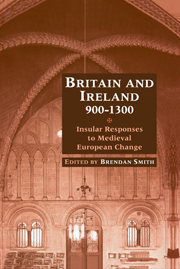Book contents
- Frontmatter
- Contents
- Contributors
- Preface
- List of abbreviations
- 1 The effect of Scandinavian raiders on the English and Irish churches: a preliminary reassessment
- 2 The changing economy of the Irish Sea province
- 3 Cults of Irish, Scottish and Welsh saints in twelfth-century England
- 4 Sea-divided Gaels? Constructing relationships between Irish and Scots c. 800–1169
- 5 The 1169 invasion as a turning-point in Irish-Welsh relations
- 6 Killing and mutilating political enemies in the British Isles from the late twelfth to the early fourteenth century: a comparative study
- 7 Anglo-French acculturation and the Irish element in Scottish identity
- 8 John de Courcy, the first Ulster plantation and Irish church men
- 9 Coming in from the margins: the descendants of Somerled and cultural accommodation in the Hebrides, 1164–1317
- 10 Nobility and identity in medieval Britain and Ireland: The de Vescy family, c. 1120–1314
- Bibliography
- Index
6 - Killing and mutilating political enemies in the British Isles from the late twelfth to the early fourteenth century: a comparative study
Published online by Cambridge University Press: 30 July 2009
- Frontmatter
- Contents
- Contributors
- Preface
- List of abbreviations
- 1 The effect of Scandinavian raiders on the English and Irish churches: a preliminary reassessment
- 2 The changing economy of the Irish Sea province
- 3 Cults of Irish, Scottish and Welsh saints in twelfth-century England
- 4 Sea-divided Gaels? Constructing relationships between Irish and Scots c. 800–1169
- 5 The 1169 invasion as a turning-point in Irish-Welsh relations
- 6 Killing and mutilating political enemies in the British Isles from the late twelfth to the early fourteenth century: a comparative study
- 7 Anglo-French acculturation and the Irish element in Scottish identity
- 8 John de Courcy, the first Ulster plantation and Irish church men
- 9 Coming in from the margins: the descendants of Somerled and cultural accommodation in the Hebrides, 1164–1317
- 10 Nobility and identity in medieval Britain and Ireland: The de Vescy family, c. 1120–1314
- Bibliography
- Index
Summary
The convention of sparing the life and limb of defeated high-status enemies visible in Germany and France (the Frankish heartland of Europe) from the end of the tenth century onwards entered English political mores in part at least as a consequence of 1066 and the influx of a new French ruling class. The diffusion of this chivalrous code is just one aspect of that much wider process of cultural homogenization which Robert Bartlett has called ‘the Europeanization of Europe’. Very likely the chivalrous ‘Europeanization of England’ would have happened without the 1066 factor – there are signs that it was beginning to happen in late Anglo-Saxon England south of the Humber – but, in the event, it was in the wake of the Norman Conquest that politics in England became chivalrous. Thus change was perceived not as Europeanization but as Frenchification. But although chivalrous compassion became fashionable in twelfth-century England, bloodier political mores continued to prevail in the rest of the British Isles. Elsewhere I have suggested that the rise of chivalrous compassion may be connected with the rising stone walls of European – and English – economic growth, that the proliferation of the towns and castles of the new landscape meant a proliferation of strong-points from which men of high status could control territory, and hence a proliferation of assets which they could, in the event of defeat, use as bargaining counters in exchange for a promise to spare their lives and/or limbs.
- Type
- Chapter
- Information
- Britain and Ireland, 900–1300Insular Responses to Medieval European Change, pp. 114 - 134Publisher: Cambridge University PressPrint publication year: 1999
- 10
- Cited by

